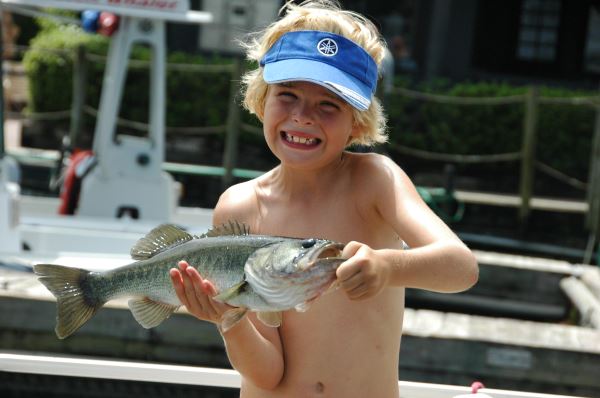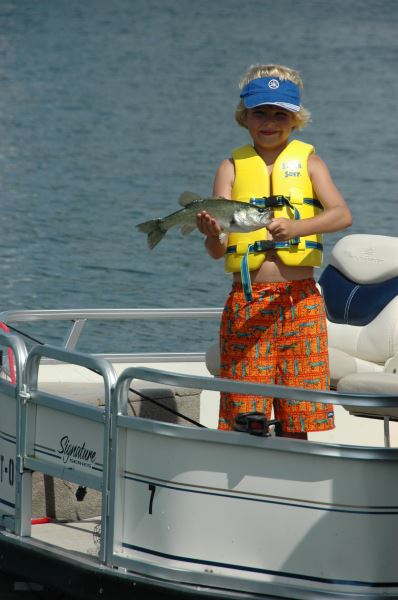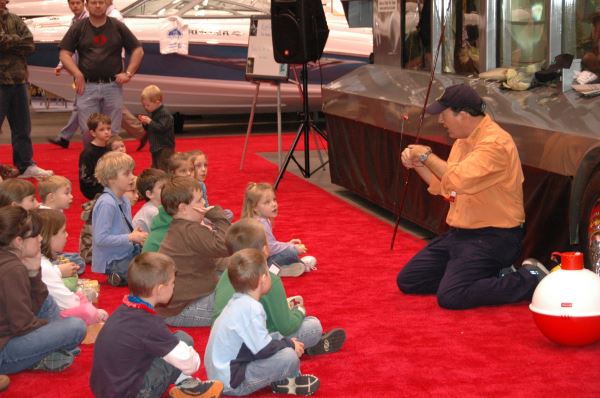I feel like one of the best things I can give my kids is time outside, especially since they spend way too much time inside on video games. It’s even better when we go on a fun outdoor adventure such as fishing. Little beats a sunny afternoon spent casting our lines for brook trout, especially if I remember to pack cookies and sodas for bribery–I mean energy.
.jpg_600.jpg) A big-time believer in helping children connect with nature by teaching them how to fish is Dan Armitage, a long-time presenter of the Kids’ Fishing Fun program at boat shows across the country. Having spent his lifetime fishing, Dan also taught his son how to fish and recently wrote a beautifully accessible how-to book for kids titled Let’s Learn to Fish!
A big-time believer in helping children connect with nature by teaching them how to fish is Dan Armitage, a long-time presenter of the Kids’ Fishing Fun program at boat shows across the country. Having spent his lifetime fishing, Dan also taught his son how to fish and recently wrote a beautifully accessible how-to book for kids titled Let’s Learn to Fish!
From Beginner To Expert
One of six kids, Dan learned to fish from his father’s aluminum boat on Hoover Reservoir in central Ohio. He gained a passion for fishing because unlike basketball or football, fishing is noncompetitive where everyone can win and enjoy the outdoors at the same time. Teaching others about fishing became Dan’s life passion and his career. He was a longtime editor of Ohio Fisherman Magazine, hosted a syndicated radio show called The Buckeye Sportsman for 26 years, and freelances fishing and outdoor articles for a handful of publications. After writing a popular article called, “Ten Tips for Teaching Kids to Fish,” Dan was encouraged by the producer of Cincinnati’s outdoor show to climb up on the show’s giant aquarium and teach a large audience of children his tips. After that, his appearance at boat shows became a regular occurrence.
Now a presenter at up to eight boat shows each season, Dan lets kids hold and hook live bait, cast their rods into fish tanks crowded with bass and panfish, and encourages them to hold their breath for as long as the fish is out of water “holding” its breath. He loves when kids think the most important thing to bring fishing is “Grandpa” instead of perhaps a fishing rod, and he appreciates when exhibitors compliment him on teaching the next generation to value nature.
 Walking The Walk
Walking The Walk
Dan was careful to teach his son Ethan to love fishing by following his own tips for success. By practicing to cast and string his line in the backyard, Ethan acquired patience and new skills before adding the excitement of the water. Dan also tried hard to follow his son’s pace for the outing, giving him the freedom to run around and leaving when his son was ready to go home. “Be careful not to push,” Dan said. “If your kids are ready to leave 20 minutes after you get there, be sure to leave so they’ll remember fishing as a fun experience and will want to go the next time you ask.”
For many years, Dan and his son fished from a Harris pontoon, and belonged to a pontoon boating club at Hoover Reservoir, the same place he had learned to fish as a boy. And he realized that a pontoon is a perfect boat to teach a kid how to fish.
“With the playpen and open deck of a pontoon, kids have room to move and aren’t as confined as they would be in a Jon boat,” Dan said. “Pontoons are stable, roomy, and self-contained. You can bring a puzzle or hot wheels cars for them to play with. Really, you can’t pick a better boat for teaching a kid to fish.”
 The years of teaching and practice paid off and Ethan’s had many successful moments, but none of them make Dan as proud as the time 8-year-old Ethan landed a 10-pound catfish by himself. During a repair break at the boating club, Dan sent Ethan to fish from the shore while he worked on the boat. After a while, Dan heard shouting and cheers as Ethan ran over holding his catch. “He hooked and reeled it in, pulled it on the bank without a net, removed the hook from the wriggling fish, and put it on a stringer so he could run it over to me for a picture. I was so proud of him because he did all of these skills on his own,” Dan recalled.
The years of teaching and practice paid off and Ethan’s had many successful moments, but none of them make Dan as proud as the time 8-year-old Ethan landed a 10-pound catfish by himself. During a repair break at the boating club, Dan sent Ethan to fish from the shore while he worked on the boat. After a while, Dan heard shouting and cheers as Ethan ran over holding his catch. “He hooked and reeled it in, pulled it on the bank without a net, removed the hook from the wriggling fish, and put it on a stringer so he could run it over to me for a picture. I was so proud of him because he did all of these skills on his own,” Dan recalled.
Now an adult, Ethan loves to join his dad each year fishing the Florida Keys in the spring and Cape Cod, Mass., in the summer. They practice catch and release most of the time, but Dan says, “Normally we eat what we catch because we’re always looking for those kinds of fish such as walleye, trout, and perch.”
All About The Book
Because his years of teaching kids to fish (plus a BS in education from Ohio State) have made him an expert on the subject, Storey Publishing approached Dan two years ago and asked him to write Let’s Learn to Fish!.
Filled with engaging photos of kids in action, the skills-based book shows kids how to fish with easy-to-follow instructions, helpful diagrams, and clear explanations. Step-by-step photos illustrate the basics of tackle from fishing with a simple line and cane pole to using a rod and reel. Ideas on where to dig for worms, catch minnows, and make homemade traps for crickets will have kids involved on every level. With full-page descriptions on something as simple as a bobber, the book outlines all of the basic skills, gear, and know-how with just the right amount of detail. Even finding the fish will be approachable for kids with a chapter on how to think like a fish and a handy map illustrating where fish love to hang out in a lake or stream.
 For Parents
For Parents
There’s also a helpful chapter directed to parents, reminding them that one of the greatest skills you can learn together is patience. By leaving your own gear at home during the early fishing lessons, you can focus on making sure your child has the attention and support they need. Another important tip is to have the very first fishing lessons on the shore. This will allow kids the space to run around, climb trees, turn over logs, and throw rocks—to just enjoy being outside doing “all the fun stuff associated with a fishing trip,” Dan said. The shore is also a better place to begin fishing because “most fish we look for come there to feed, hide in the rocks, and stay out of the sun,” he said.
I love the reminder that even though you may have to wait for a bite on your line, or take extra time untangling a pile of equipment, the fun of fishing starts right away when you’re outdoors and you’re together. This summer I’d like to teach my own kids to use a bobber and a stringer, and to identify the kinds of fish we find. If I can help them love an outdoor hobby such as fishing, they’ll be drawn to spend more time in nature and will have a go-to adventure they can be involved in for their entire lives.

